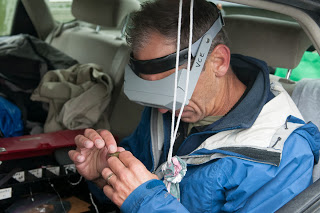After nearly two months away from our favorite mountain haunt, VCE staff could hardly resist a final
Mt. Mansfield “fix”. A mid-September overnight foray to our long-term ridgeline study plot has become an annual rite of passage, intentionally timed to coincide with the autumnal resurgence of Bicknell’s Thrush activity. Some years, we’ve had remarkably productive mist-netting, and it’s always a delight to be back up there.
This fall, with little latitude in our schedules to wait for optimal weather, four of us ascended the Mansfield toll road in late afternoon on September 13. We hung our hats on a forecast that predicted slowly clearing skies, after several days of cool rains. Above, thick clouds draping the ridgeline provided our first clue of what awaited. We were greeted by hypothermic conditions that precluded any possibility of mist-netting — temperatures in the low 40sF, buffeting winds, and soaking clouds. We struggled with numb fingers to set up 10 nets, hoping (with low confidence) that conditions might improve by daybreak. They didn’t, and temperatures had in fact dropped to the high 30s. After our second cup of coffee in the ski patrol hut, we decided to venture up to the ridgeline, arriving ~7:30 am. Winds were a bit lower than during the previous night, and several Bicknell’s Thrushes (BITH) were calling, a few even breaking into song.
Knowing this represented our last chance for field work in 2013, we decided to open nets, check them constantly, and try a few playbacks. Surprisingly, we caught a BITH right off the bat, then another, then a Golden-crowned Kinglet, then another BITH, then…the wind dropped slightly and the temp soared to 39F. We managed to keep our 10 nets open until noon, banding inside a cramped but relatively warm Prius. When all was said and done, we had netted 5 BITH — 3 adults (including one male we banded back in June) and 2 immatures. We also banded 2 kinglets, 1 adult Blackpoll and 1 immature Yellow-rumped warbler. Hardly a major haul, but far better than we had expected when peering out the ski patrol hut windows at dawn.
BITH were far and away the most conspicuous birds on the ridgeline, with at least 8 heard. As usual, they proved themselves far more hardy than us humans. Their annual mid-September resurgence of activity is puzzling, but probably related to the fact that many of them will be right back on the ridgeline about 7 months from now. Most will depart for their Greater Antillean wintering grounds during the latter half of September, though a few will linger into early October. Some may well have pushed off with the clearing cold front that passed that very night, within hours after we hightailed it down the mountain.
A handful each of Yellow-rumped Warblers and Golden-crowned Kinglets completed our avian encounters outside of netting, although a distant raven croaked once or twice.
Not a single junco or White-throat was seen or heard. We didn’t manage to attach our 20th and final geolocator to a Blackpoll Warbler (our fingers were too numb to manipulate the unit on our one netted adult!), but the 19 units that we attached to birds in June and July are now collecting data that will yield priceless insights when we retrieve them next spring.


